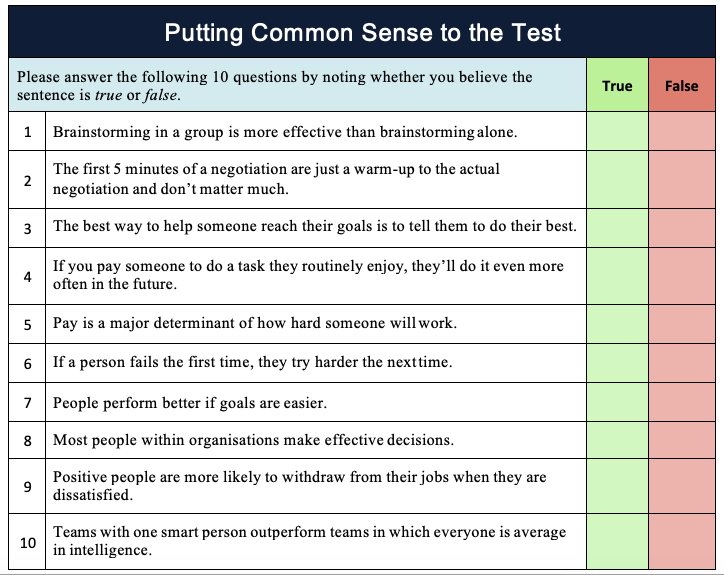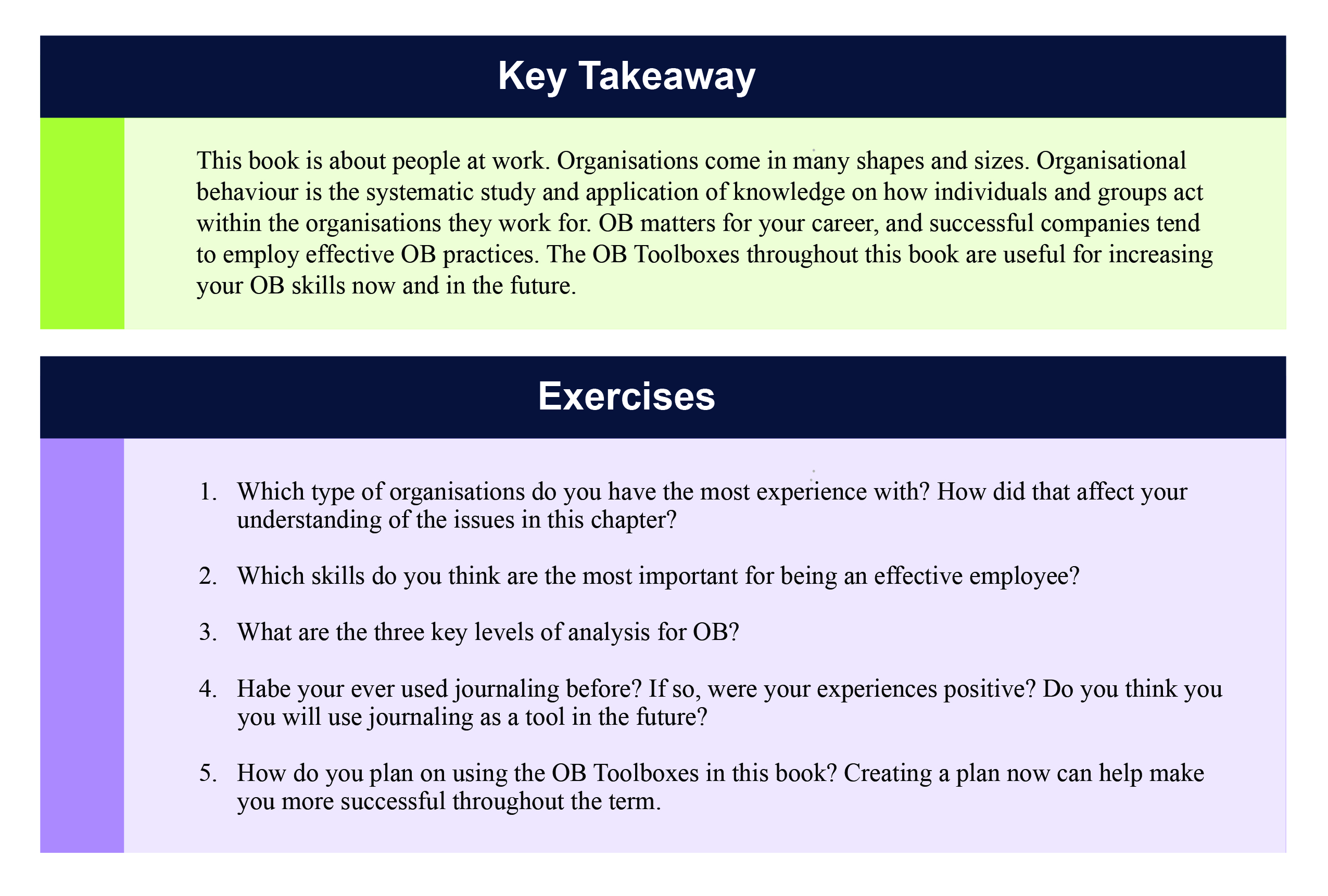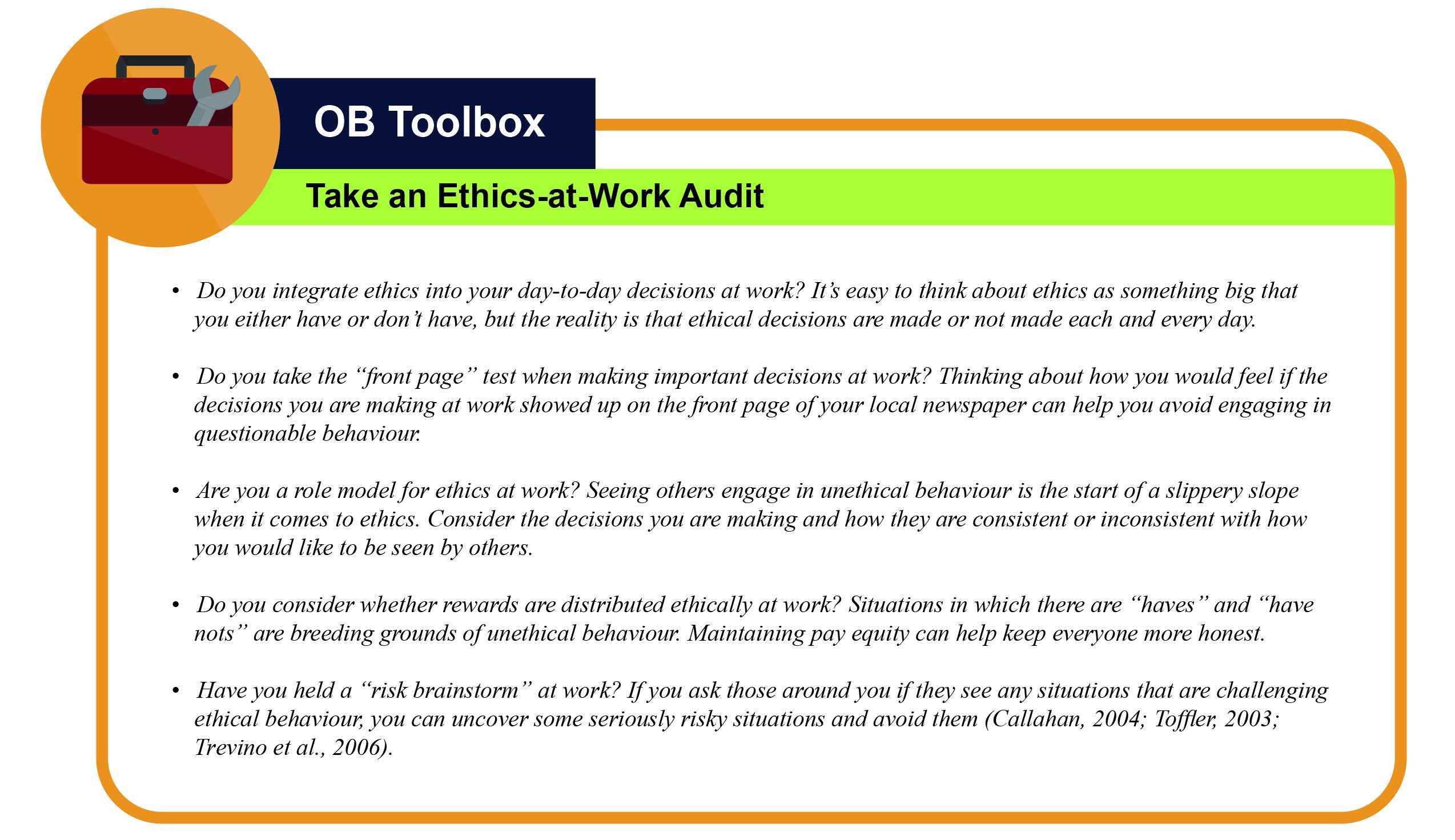Chapter 1: What Is Organizational Behavior?
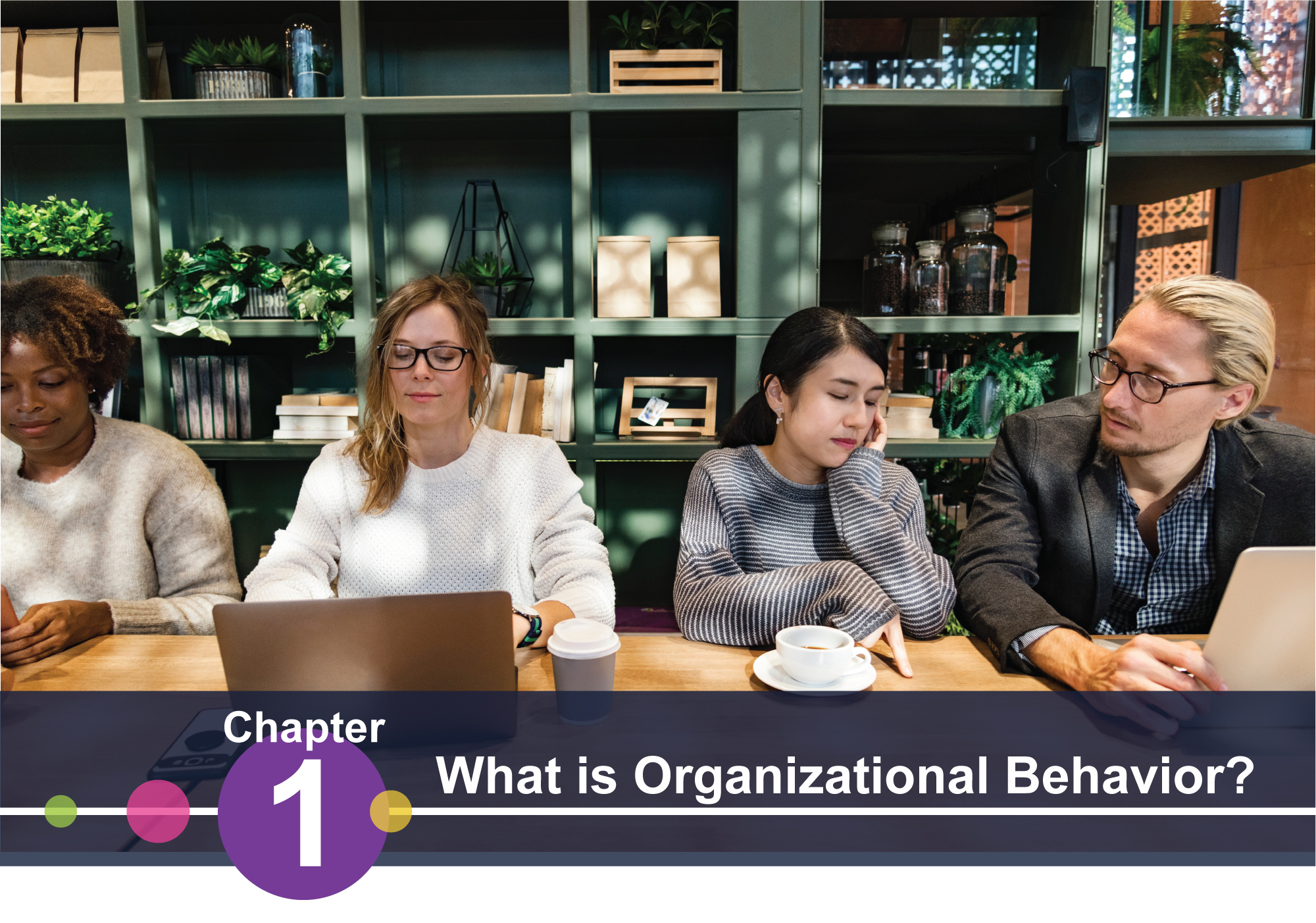
Chapter Learning Outcomes
After reading this chapter, you should be able to know and learn the following:
-
- What organizational behaviour (OB) is.
- Why organizational behaviour matters.
- What the challenges are for OB.?
- What the opportunities are for OB.?
Introduction
The most successful business leaders are the ones that continuously look for ways and strategies to drive performance, not only through improving employee productivity, but also their workspace experience and job satisfaction. This can be achieved by understanding how employees interact with each other and with management as well as what motivates them.
This book is therefore all about people, especially people at work. We will share many examples of people making their workplaces fit their needs as companies find ways to support them. People can make work an exciting, fun, and productive place to be; or they can make it a routine, boring, and ineffective place where everyone dreads going.
Great Place to Work® is the global authority on building, sustaining and recognizing High-Trust, High-Performance Culture at workplaces. Every year they learn from great leaders, survey millions of employees, and examining thousands of the best workplaces around the globe.
Among the top 5 companies to work at in Canada, as rated by Great Place to Work®, is Salesforce Inc. with nearly 4000 employees at their Canadian office. Salesforce is a global marketing software company that provides a broad range of internet-based customer-relationship and customer-management services. Forbes magazine called Salesforce, Inc. the most innovative company in America every year since 2011.
Marc Benioff, the CEO of Salesforce says this about people, “… customer success depends on every stakeholder. By that I mean employees who feel engaged and responsible and are growing their careers in an environment that allows them to do their best work—and this applies to all employees, from the interns to the CEO.”
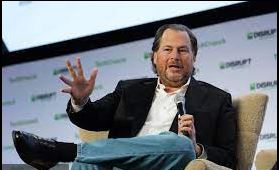
Just like people, organizations come in many shapes and sizes. We understand that the career path you will take may include a variety of different careers and organizations. Some people stay in the same job or field of work for their entire lives. Many people, however, try different types of work, such as food service, hospitality, retail or business, before finding a career that fits. Even then, years later, for a variety of reasons, they may decide to change careers and do something different. In order to succeed in this type of career situation, individuals need to be armed with the tools necessary to be lifelong learners. This book will not give you all the answers to every situation you may encounter in your career. Instead, it will give you the vocabulary, framework, and critical thinking skills necessary for you to diagnose situations, ask tough questions, evaluate the answers you receive, and act in an effective and ethical manner in various professional scenarios.
Throughout this book, we will use examples of organizations that are publicly held and for-profit companies like Google, Starbucks, TD Bank, Shopify, Airbnb, etc. We will also focus on both small as well as small start-up companies to highlight how the quality of the people that form teams matters more to business success than the size of the organization.
Together, we will examine people at work both as individuals and within work groups. We will study how they impact and are impacted by the organizations they work for. Before we can understand the different levels of organizational behaviour, we first need to agree on a definition of organizational behaviour.
Organizational behaviour (OB) is the study of how people think, feel, and behave individually or in groups within organizations. The goal of OB is to understand the behaviour of people at work in order to develop interventions, systems, and processes that create happier and more productive employees, more effective leaders, and more meaningful work. As you will see throughout this book, definitions and concepts are important. They are important because they tell us what something is, as well as what it is not. For example, we will not be addressing childhood development in this course—the concept is often covered in psychology—but we might draw on research about twins raised apart to understand whether job attitudes are affected by genetics.
OB draws from other disciplines to create a unique field. As you read this book, you will most likely recognize OB’s roots in other disciplines. For example, when we cover topics such as personality and motivation, we will again review studies from the field of psychology. The topic of team processes relies heavily on the field of sociology. In the chapter relating to decision making, you will encounter the influence of economics. When we study power and influence in organizations, we borrow heavily from political sciences. Even medical science contributes to the field of Organizational Behaviour, particularly to the study of stress and its effects on individuals.

Those who study organizational behaviour—which now includes you—are interested in several outcomes such as work attitudes (job satisfaction and organizational commitment) and job performance (customer service and counterproductive work behaviors).
A distinction is made in OB regarding which level of the organization is being studied at any given time. There are three key levels of analysis in OB: the individual, the group, and the organization. For example, if I want to understand my boss’s personality, my analysis would be at the individual level. If I want to understand how my manager’s personality affects the team, I will consider the team level. But, if I want to understand how my organization’s culture affects my boss’s behaviour, I would be interested in the organizational level of analysis.
Why Organizational Behavior (OB)Matters
The pandemic years of 2020 and 2021 have been ones of trauma and turmoil, world over. As each one of us experienced its effects in our own personal way, so did the individual at the workplace, the teams that she worked with and the organisation that she was a part of. As the world limps back to a new normal, individuals are questioning old routines like the 9-5 job that did not include hours spent in travel to and from the office. Many are now seeking opportunities that would allow them to have a better work-life balance. Teams find that using Zoom allow for on-time meetings and seamless coordination. Organisations are making attempts to adapt to new preferences by offering work from home or hybrid work.
OB therefore matters to three key stakeholders. Firstly, it matters to workers. OB can help employees become a more engaged organizational member. Getting along with others, doing great work, lowering stress levels, making more effective decisions, and working effectively within a team—these are all things OB addresses!
Secondly, OB matters to employers. People who are satisfied with the way they are treated on the job are generally more pleasant to their co-workers and bosses and are less likely to quit than those who are dissatisfied with the way others treat them (Judge & Church, 2000; Greenberg, 2005).
Finally, it matters to organizations. The best companies in the world understand that the people make the place. How do we know this? Well, we know that organizations that offer good employee benefits and that have friendly conditions are more profitable than those who are less people oriented (Bollinger, 1996; Greenberg, 2005).
Research shows that successful organizations have several things in common such as providing employment security, engaging in selective hiring, utilizing self-managed teams, being decentralized, offering competitive compensation, training employees, reducing status differences, and sharing information (Pfeffer & Veiga, 1999).
Research also shows that organizations that are considered healthier and more effective have strong OB characteristics such as role clarity, information sharing, and performance feedback. Unfortunately, research shows that most organizations are unhealthy, with 50% of respondents saying that their organizations do not engage in effective OB practices (Aguirre et al., 2005).
The OB Toolbox – preparing you for the world of work
In this chapter, we will cover how you can add ideas from this book to your OB Toolbox in each section and assess your own learning style along the way. In addition, it is important to understand the research methods used to define OB, so we will also review those. Finally, you will see what challenges and opportunities businesses face and how OB can help overcome these challenges.
Throughout the book, you will read through many OB Toolbox features. Our goal is to create something useful for you to use now and as you progress through your career. Sometimes we will focus on tools you can use today. Other times we will focus on things you may want to consider in the future. As you progress, you may discover some OB tools that are particularly relevant to you while others are not as relatable now. You can always go back and pick up tools later if they do not seem applicable right away.
The important thing to keep in mind is that the more tools and skills you have, the higher the quality of your interactions with others will be and the more valuable you will become to organizations that compete for top talent (Michaels, Handfield-Jones, & Axelrod, 2001). It is not surprising that, on average, the greater the level of education you have, the more money you will make (Education and training have financial payoffs as illustrated by these unemployment and earnings for workers 25 and older. Source: U.S. Bureau of Labor Statistics, http://www.bls.gov.)
Tom Peters is a management expert who talks about the concept of thinking of oneself as a brand to be managed. Isn’t that interesting? Just as you buy your favourite brands because of the many benefits, features and at times social status that they provide you with, so it is with your personal brand. Why you will be hired, become a welcome member of your team and grow in your career will depend much on how you manage your personal brand. The many concepts that you will learn through this book will help you develop your brand image.
OB is also important when determining whether an organization is effective or not. Organizational effectiveness requires assessing: (1) how well the organization performs, (2) how well the internal operations function, (3) what external factors are impacting the organization, and (4) the perceptions of shareholders, managers, and customers (Richard et al., 2009). There are various internal aspects of the organization that need to be examined, including the following:
• Decision Making
• Change & Learning
• Group Effectiveness
• Self-Organizing and Adaptive Systems
All of the above areas are studied in OB!
Isn’t OB Just Common Sense?
Have you ever had a job where people didn’t get along, nobody knew what to do, everyone goofed off, and your boss was, well, unpleasant? If you have, then you would not have liked working in that company at all.
Now, think of another position in which everyone was friendly. In such a situation, you are likely to be interested in going to work, doing your best, and taking pride in what you do. At the heart of these differences are all issues that are of great concern to Organizational Behavior scientists and practitioners.
You may be thinking “Okay, in some companies things are nice and smooth, but in others, relationships are rocky – does it really matter?” “How can the study and application of OB concepts make a difference.”?
As teachers, we have heard these question many times. The answer, as you might have guessed, is no—OB is not just common sense. As we noted earlier, OB is the systematic study and application of knowledge on how individuals and groups act within the organizations they work for. Systematic is an important word in this definition. It is easy to think we understand something if it makes sense, but research on decision making shows that this can easily lead to faulty conclusions because our memories fail us. We tend to notice certain things and ignore others. The way we frame information can affect the choices we make. Therefore, it is important to rule out alternative explanations one by one rather than assuming we know human behaviour just because we are humans! Go ahead and take the following quiz and see how many of the 10 questions you get right. If you miss a few, you may realize how OB isn’t just common sense. If you get them all right, you are way ahead of the game!
Note: What is journaling: It’s simply writing down your thoughts and feelings to understand them more clearly. And if you struggle with stress, depression, or anxiety, keeping a journal can be a great idea. It can help you gain control of your emotions and improve your mental health.
1.1 Trends and Changes
Challenges and Opportunities
There are many trends within the workplace and around the globe that have and will continue to affect the workplace and your career. We are sure you have noticed many of these trends simply by reading news headlines. We will highlight some of these trends along with the challenges and opportunities they present for students of organizational behaviour.
Ethical Challenges
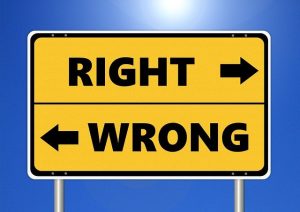
Business ethics refers to applying ethical principles to situations that arise either with customers or with employees. With customers ethical practices could be charging fair prices or responding to complaints. Unethical practices examples could be false product claims, fake reviews on the web and hidden terms in user agreements.
On the other hand, businesses try to get ahead unethically by treating employees unfairly. This can keep costs down and improve productivity. Poor treatment of employees, sexual harassment, bribery, selling customer data, fraudulent accounting practices are some examples of unethical practices.
A former employee of Facebook, data scientist Frances Haugen was busy exposing Facebook’s means of keeping users addicted by keeping everyone hate-filled and angry, and how Instagram was an after-school club where the main activity was eating disorders and body dysmorphia – and she had the receipts to prove it. “During my time at Facebook, I came to realize a devastating truth: Almost no one outside of Facebook knows what happens inside Facebook,” Haugen told the U.S. Congress. “The company intentionally hides vital information from the public, from the U.S. government, and from governments around the world.”
Investors forced Mr. Travis Kalanick, founder and former CEO of Uber to resign as chief executive in 2017, after a series of privacy scandals and complaints of discrimination and sexual harassment at the company. The chairman and chief executive of Wells Fargo & Co., ( a highly valued American bank) , John Stumpf, resigned in 2016 in the aftermath of a scandal over the bank’s past practice of secretly selling services to unsuspecting customers. Ferrero USA is the company behind the brand Nutella. It was forced to pay a settlement of $3.05 million after settling a class action lawsuit for false advertising that its chocolate spread is a nutritious choice for children. For years, Foxconn has been accused of violating labor rights. Leaks revealed that the company employs children as young as 14 years old to work in its factories in China. The supplier provides products to both Apple and Amazon. In the Volkswagen emissions scandal, the company admitted to having installed software that manipulated emissions readings to make its cars appear as if they were environmentally friendly.
The AIG, Tyco International, WorldCom, and Halliburton Energy Services have all been examples of poor judgment or outright illegal behaviour. The immediate response by government has been the Sarbanes-Oxley Act, which went into effect in 2002. This act consists of 11 different requirements aimed at greater accountability, which companies must follow in terms of financial reporting and compliance. While there may be some benefits to businesses from complying with these rules (Wagner & Dittmar, 2006), few see this as the long-term solution to dealing with unethical behaviour. The challenge is to continue to think about business ethics on a day-to-day basis and institute cultures that support ethical decision making. There is great opportunity for organizations to be on the forefront of ethical thinking and actions. OB research finds that the most important determinant of whether a company acts ethically is not necessarily related to their ethical conduct policies and rules. Instead, the most valuable indicator is whether a company has a culture that fosters consistent ethical behaviour and leaders who are committed to it (Driscoll & McKee, 2007).
The Effects of the Pandemic

For all the difficult and devastating consequences of the pandemic, it has also taught us that a new and better way of working is possible. We’re learning that workplace flexibility and productivity go together, and many even found more meaning in their work during the pandemic than they did before.
Qualtrics (web-based software that allows the user to create surveys and generate reports), asked over 4,000 global employees who had shifted from in-person to remote work at some point during the pandemic about their expectations and desires for the future of work. As companies and organizations navigate the return to work, they’ll need to recognize that people’s needs, and priorities have shifted during the last year. Leaders have a unique opportunity to listen directly to their customers and employees and build on what they’ve learned during lockdown.
The research revealed that flexibility is the future.
The ability to travel, move, and live away from an office — while still working their jobs — gave many a flexibility they don’t want to give up after the pandemic is over.
- Over half of respondents (53%) said a long-term remote work policy would make them consider staying at their organization longer, and 10% said they would probably quit their job if they were forced back into the office full-time
- 80% of employees looking for a new job said it was important to them that their next job offer them the opportunity to live anywhere
- The younger generation seems to be more mobile: 25% of Gen Z (anyone born from 1997 to 2012) and 17% of Millennials (anyone born from 1981 to 1996) said they moved during the pandemic, compared to less than 10% of Gen X and Baby Boomers
Most don’t want to ditch the office completely, however. Many employees and leaders believe offices with a hybrid arrangement will outperform those without, especially as they cater to the individual needs of their employees.
How organisations will adapt to rapidly evolving employee preferences will determine the quality of talent that they will attract. OB facilitates the study of how to understand workplace emotions, attitudes, stress and motivation.
Lack of Employee Engagement
” The business of business is people” said the late Chairman of Southwest Airlines, Herb Kelleher . Southwest is among the world’ 5 most profitable airlines. Studies suggest that fostering engagement, a concept related to passion, in employees has a significant impact on the corporate bottom line. Gallup, (a company became known for its public opinion polls conducted worldwide) for instance, has been on the forefront of measuring the impact of what is called employee engagement. Employee engagement is a sense of purpose, belonging, and commitment to an organization, particularly a focused, intense, (for example: what effort do I put into my work?) persistent, (for example: how can I demonstrate consistency in my work?) and purposive effort( for example: what purpose does my work serve?) toward work-related goals.
An engaged employee is a person who is fully involved in and enthusiastic about their work (Employee engagement, 2008). The consulting firm Blessing White offers this description of engagement and its value: “Engaged employees are not just committed. They are not just passionate or proud. They have a line-of-sight on their own future and on the Organization’s mission and goals. They are ‘enthused’ and ‘in gear’ using their talents and discretionary effort to make a difference in their employer’s quest for sustainable business success” (Blessing White, 2008).
Engaged employees are those who are performing at the top of their abilities and happy about it. According to statistics that Gallup has drawn from 300,000 companies in its database, 75% – 80% of employees are either “disengaged” or “actively disengaged” (Gallup Press, 2006).
That’s an enormous waste of potential. Consider Gallup’s estimation of the impact if 100% of an organization’s employees were fully engaged:
- Customers would be 70% more loyal.
- Turnover would drop by 70%.
- Profits would jump by 40%.
Job satisfaction studies in the United States routinely show job satisfaction ratings of 50% – 60%. But one recent study by Harris Interactive of nearly 8,000 American workers went a step further (Zinkewicz, 2005). What did the researchers find?
- Only 20% feel very passionate about their jobs.
- Less than 15% agree that they feel strongly energized by their work.
- Only 31% (strongly or moderately) believe that their employer inspires the best in them.
According to the U.S. Bureau of Labor Statistics, during the period of the pandemic, nearly four million Americans quit their jobs in July 2021 alone. The resignation rate in the U.S. is now at a two-decade high, with more than 11 million jobs open. One recent study found that 95% of workers would consider a job change. Harvard Business Review noted that employees between the ages of 30 and 45 have had the greatest jump in resignation rates, with an average increase of more than 20% between 2020 and 2021. As Time Magazine put it, “the pandemic revealed just how much we hate our jobs.”
This, then, is more than just a Great Resignation. This is a state of discontent. A state of a lack of employee engagement and commitment.
Engagement is both a challenge and an opportunity for OB.
Technology

Technology has transformed our life, our living and the way work gets done, creating many great opportunities.
The nexus of increasing personal computing power, the Internet, as well as nanotechnology are allowing creations that were unimaginable 50 years ago. The rise and rise of social media applications, that are on your phone and the fact that there is an app for everything have allowed us to connect to the world instantly. The rate of technological change is not expected to slow down anytime soon. Gordon Moore, cofounder of Intel Corp., shocked the world in 1975 with what is now termed Moore’s Law, which states that computing power doubles every 2 years. This explains why a 4-year-old computer can barely keep up with the latest video game you have purchased. And why with each new release of the Apple iphone, more features were added to make our experiences frictionless, easy and enjoyable. As computers get faster, new software is written to capitalize on the increased computing power. Our phones and computers have varied Operating Systems. Five of the most common operating systems are Microsoft Windows, Apple macOS, Linux, Android and Apple’s iOS.
We are also more connected by technology than ever before. Zoom transformed the way we connected during the pandemic. Imagine if we had no such access to video-based conferencing. How would students have had the opportunity to connect with their educational institutions? Through giving employees options of WFH (Work From Home) and Hybrid work (work from both home and office) technology has brought convenience into work-life integration but also a great deal of challenges to individuals and organizations alike. Isolation, Discomfort, difficulty in collaboration, Zoom fatigue, band-width and privacy issues (not feeling comfortable to keep the camera on during conversations) and work-life balance are some of the challenges that both employees and organisations have to increasingly consider. To combat the overuse of video conferencing and e-mail, companies such as Deloitte in Canada have instituted “no Zoom Fridays,” in which all communication is done via other channels.
In December 2020, Sundar Pichai, CEO of Alphabet( Google) delivered a speech virtually at the Singapore FinTech Festival emphasizing inclusive digital economy.
He said , ” The coronavirus outbreak has sped up the adoption of digital tools and trends by years……..Southeast Asia’s Internet economy is currently on the verge of a massive transformation……more than 40 million people in the region connected to the Internet for the first time in 2020 – four times as many as the year before……while Covid has accelerated the use of digital tools, …….”
Businesses and organizations across the world will have to find newer and better ways to use technology as an enabler to build more productive teams and hence drive productivity.
This technology trend contains challenges for organizational behaviour.
Flattening World

Thomas Friedman’s book The World Is Flat: A Brief History of the Twenty-First Century makes the point that the Internet has “flattened” the world and created an environment in which there is a more level playing field in terms of access to information. This access to information has led to an increase in innovation, as knowledge can be shared instantly across time zones and cultures. It has also created intense competition, as the speed of business is growing faster and faster all the time. In his book Wikinomics, Don Tapscott notes that mass collaboration has changed the way work gets done, how products are created, and the ability of people to work together without ever meeting.
There are few barriers to information today, which has created huge opportunities around the globe. Marc Andreessen, cofounder of Netscape Communications Corporation, notes, “Today, the most profound thing to me is the fact that a 14-year-old in Romania or Bangalore or the Soviet Union or Vietnam has all the information, all the tools, all the software easily available to apply however they want” (Friedman, 2005). Of course, information by itself is not as important as having the right information at the right time. A major challenge for individuals in the flattened world is learning how to evaluate the quality of the information they find. For tips on how to evaluate the quality of information, see the OB Toolbox below.
The concept of ” The World is flat” can now be extended to the war in Ukraine. In this interconnected, flat world. what happens in one corner of the world rapidly affects other parts. The costs of war in terms of rising inflation, fuel and food costs may, according to the United Nations, lead to billions of people facing the greatest cost-of-living crisis in a generation.
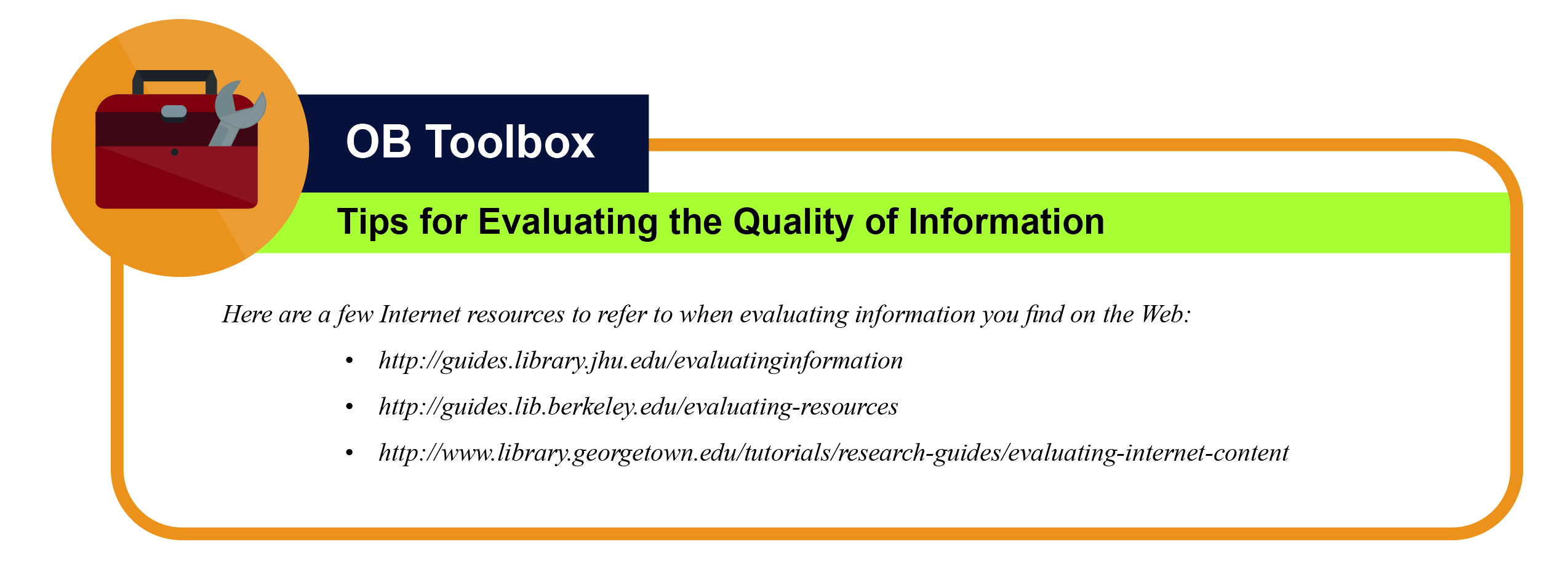
Mini Case Scenario
Delta Marketing Inc. is a marketing firm with offices in multiple countries. When the pandemic hit, the company quickly shifted to remote work to ensure the safety of their employees. This sudden change in work environment had a significant impact on employee behavior and organizational functioning. During the pandemic, remote work resulted in changes in employee behavior at the individual and team levels.
At the individual level, employees experienced changes in their work-life balance and mental health. The blurring of boundaries between work and home life resulted in increased stress and burnout. Employees also experienced social isolation, which impacted their mental health and well-being.
At the team level, the shift to remote work resulted in changes in communication and collaboration. The lack of face-to-face interaction made it difficult for teams to collaborate effectively and build relationships. The shift to virtual meetings and online communication platforms resulted in an increase in communication technology fatigue.
After the pandemic, Delta chose to continue with remote work as a permanent option. This decision resulted in additional changes in employee behavior and organizational functioning.
At the individual level, employees experienced increased flexibility and autonomy in their work. Remote work allowed employees to better manage their work-life balance and reduced commuting time.
At the team level, remote work resulted in changes in communication and collaboration. The organization implemented new policies and procedures to ensure effective communication and collaboration, such as regular check-ins and virtual team meetings. The organization also invested in technology to better support remote work.
Delta’s domestic competitor, on the other hand, adopted a policy of hybrid functioning, requiring its employees to come in to office at least twice a week. This policy received an adverse response from the employees who felt that the organisation would lose all the gains made in the last few years of the pandemic, such as higher productivity, better work-life balance, improved flexibility and are threatening to go on strike.
While there are pros and cons of each of the above approaches, in your opinion, which approach would provide a healthier organisational environment, a happier and more productive work force and provide long term sustainable growth to the organisation? Provide reasons for your choice.
Sustainability and Green Business Practices
The primary role of for-profit companies is to generate wealth for their shareholders. More recently, the concept of the triple bottom line has been gaining popularity. Those subscribing to the triple bottom line (People, Planet and Profit) believe that beyond economic viability, businesses need to perform well socially and environmentally. While some organizations have embraced the triple bottom line, businesses are also undergoing a great deal of “greenwashing,” where products or processes are marketed as green to gain customers without truly engaging in sustainable business practices. Sustainable business practices are those that meet the present needs without compromising the needs of future generations. The challenge is to reconcile the accountability that publicly owned firms have to their shareholders while attending to the triple bottom line.
On the other hand, organizations also have an opportunity to proactively innovate for not only sustainability but also even greater profits. For example, sales of the Toyota Prius, which combines combustion engine efficiency with hybrid electric technology, have been dramatic and have helped propel Toyota to record market share and profits. Tesla, with its Electric Vehicle is becoming an aspirational brand.
An unlikely leader in the sustainability movement is Wal-Mart. In Canada, Wal-Mart has done away with plastic bags encouraging customers to carry their own shopping bags. This is a big moment for Wal-Mart’s associates and customers: making this change will help to prevent more than 680 million single-use plastic bags from entering circulation each year. For context – that’s enough bags to circle the world nearly 10x!
Wal-Mart hired Adam Werbach, the former president of the Sierra Club, to help train 1.3 million North American Wal-Mart employees on sustainability. Wal-Mart has also been pressuring suppliers to produce compact fluorescent lightbulbs with less mercury and has slashed the resources needed in packaging by requiring all suppliers to make packages smaller (Fetterman, 2006; Sacks, 2007). In the future, increasing interdependence between businesses, governmental agencies, and NGOs is bound to effect change throughout the economy (Campbell, 2007; Etzion, 2007).
Sustainability practices
David Takayoshi Suzuki CC OBC FRSC is a Canadian academic, science broadcaster, and environmental activist. Suzuki earned a PhD in zoology from the University of Chicago in 1961, and was a professor in the genetics department at the University of British Columbia from 1963 until his retirement in 2001.
In his webiste “Living Green” David tells us how we can protect, respect and restore nature, and support safer, healthier communities.
What are you doing to protect, respect and restore nature?
Here are 30 ways to make your life more environmentally freindly and sustainable.
Aging Workforce and the Millennial Generation

You have probably heard that the American workforce is aging. Over the next 30 years, 76 million baby boomers (Generation born between 1946-1964) will retire, but there will only be 46 million new workers from Generation X (born between 1965-1976) and the Millennial Generation Y (born between 1981-1996) in and entering the labor force. For example, everything from air traffic controllers to truck drivers are predicted to be in huge demand as thousands of retiring workers leave these industries at roughly the same time (Ewart, 2008; Watson, 2008).
Early in 2022, Statistics Canada released a report stating that: “the working-age population, persons aged 15 to 64 who produce the bulk of goods and services in the Canadian economy, has reached a turning point. Never has the number of people nearing retirement been so high. More than 1 in 5 (21.8%) persons of working age are aged 55 to 64. This is an all-time high in the history of Canadian censuses and one of the factors behind the labour shortages facing some industries across the country. The aging of many baby boom groups—the youngest of whom are between 56 and 64 years today—is accelerating population aging in general”.
The report further says: ” These demographic shifts will change the face of the working-age population, which is becoming more educated and ethnoculturally diverse, given greater diversity among younger generations. In addition, young generations may have different values and expectations from those of their predecessors, such as work–life-leisure time balance, and job flexibility.”
The Millennial Generation differs from previous generations in terms of technology and multitasking as a way of life. Having never known anything different, this population has technology embedded in their lives and are therefore called ” digital natives” whereas the older generations who are not as versatile as the Millennials and Gen X are called ” digital immigrants” – a person born or brought up before the widespread use of digital technology. In addition, the Millenials value teamwork, feed- back, and challenging work that allows them to develop new skills. If you are in this generation or know those who are, you know there is an expectation of immediate interaction (Oblinger, 2003). The challenge for organizational behaviour is to keep individuals of different generations communicating effectively and managing people across generational lines despite differing values on teamwork, organizational rewards, work–life balance, and desired levels of instruction.
The Global Marketplace for Staffing: Outsourcing and Offshoring
Outsourcing occurs when a company contracts a specific process out to a third party, finding someone who specializes in whatever needs to be done. Outsourcing has become a way of life for many organizations—especially those based in the United States who are outsourcing to countries where labor is relatively inexpensive. This practice can involve temporary employees, consultants, or even offshoring workers. Sportswear giant Nike outsources the production of all its footwear to various overseas manufacturing plants. According to a report out of Ohio State University, China does 36% of all Nike’s shoe manufacturing, while Vietnam has another 36%, Indonesia accounts for 22%, and then Thailand comes in at 6%. While their apparel is manufactured in 41 countries including Chia, Vietnam, Thailand, Indonesia, Sri Lanka, Pakistan, and Malaysia as their top countries.
Outsourcing can also happen within a country. A baker may find making cream for cakes too expensive and therefore outsources it to a manufacturer who specializes in creams for cakes. Both he manufacturer and the outsourced company are within the same country.
Offshoring happens when businesses send in-house jobs overseas. Both may save a company money, but only offshoring specifically means sending jobs out of the country.
Nowhere is there more outsourcing and offshoring than in the software technology industry. A survey of software developers revealed that 94% outsource project work. When they offshore, the work most frequently goes to India, Singapore, Russia, and China (McGee, 2007). Microsoft has been expanding their use of employees in Canada for a variety of reasons such as closer proximity to Microsoft’s headquarters in Seattle, Washington, as well as similarity of language and time zones.
Charles Handy, author of The Age of Paradox, coined the term shamrock organization, which is an organization comprised of one-third regular employees, one-third temporary employees, and one-third consultants and contractors. He predicts that this is where organizations are headed in the future. The darker side of the changing trend in organization composition revolves around potential unemployment issues as companies move toward a shamrock layout. Fortunately, this shift also presents an opportunity for organizations to staff more flexibly and for employees to consider the tradeoffs between consistent, full-time work within a single organization versus the changing nature of work as a temporary employee, contract worker, or consultant—especially while developing a career in a new industry, in which increased exposure to various organizations can help an individual get up to speed in a short amount of time. The challenge for organizational behaviour is managing teams consisting of different nationalities separated not only by culture and language but also by time and space.
1.2 Maintaining Core Values: The Case of Nau
A relatively young company, Nau (pronounced “now”) was founded on the idea of using business as a vehicle for change, but its path has not been easy. Nau was established in 2005 by a group of like-minded individuals from Pacific Northwest clothing companies such as Patagonia, Nike, and Marmot. Their goal was to create outdoor urban apparel constructed from sustainable materials and processes, with the entire life cycle of the product in mind. This includes taking into account the cultivation of textiles all the way through to end-of-life disposal. After 3 years of aggressive growth and expansion, Nau declared bankruptcy in the spring of 2008 when they could not secure further funding. But only a few short months later, Nau reopened as a subsidiary of outdoor clothing company Horny Toad Inc., headquartered in Santa Barbara, California. Although Nau is part of a larger company, it has been able to create a balance between the ideals of a small, independent, entrepreneurial business while being a successful part of a larger company.

The power structure that Nau shares with Horny Toad is decentralized; logistically, the companies share a human resources department, IT, warehousing space, and finances, but Nau maintains its product independence and business strategy. From the time of its inception, Nau created a network of close relationships with its overseas manufacturers, which allowed the company the power and ability to closely control its production process. During the transition, Nau desired to maintain these relationships and so endure the arduous process of explaining its bankruptcy to overseas vendors and attempting to explain the process of transferring debt and liabilities from one company to another. Although the people and faces were the same, they were no longer connected with that debt. Nau’s small size enabled it to effectively control its supply chain and to determine everything from which farm its raw materials come from to how and where textiles are produced. For Nau, responsibility does not end with the consumer’s purchase. Other changes include the number of employees at Nau, which prior to the bankruptcy was 65. In 2010, this number is down to 15 employees. While several of the individuals who took part in the founding of the company are still there, change was not embraced by all. Some felt that becoming part of a larger company would make it difficult to maintain the original core values and beliefs.
So far, these changes have been good for the company and good for business. Nau was acquired at the beginning of an economic downturn, and for a company that is dependent on consumer discretionary spending, this might have been a recipe for failure. But business is picking up for Nau, and it has been able to continue its Partners for Change program, in which Nau donates 2% of each sale to one of its partner organizations, such as Mercy Corps, Kiva, or Ecotrust—together working to create positive economic and social change.
Based on information from an interview with Jamie Bainbridge, director of textile development and sustainability at Nau. Additional information from Nau website (http://www.nau.com) and Future Fashion White Pages (http://www.earthpledge.org/ff).
1.3 Conclusion
This chapter is designed to familiarize you with the concept of organizational behaviour. We have covered methods organizations might use to address issues related to the way people behave at work. In addition, you should now be familiar with the large number of factors, both within an individual and within the environment, that may influence a person’s behaviors and attitudes. In the coming years, society is likely to see a major shift in the way organizations function as a result from rapid technological advances, social awareness, and cultural blending. OB studies hope to enhance an organization’s ability to cope with these issues and create an environment that is mutually beneficial to the company as well as its employees.
We conclude this introduction to Organizational Behaviour. As shown in the graphic below, the first 6 chapters will be focused on the Individual – who is at the heart of the organisation, the next 6 chapters on the Group and then one chapter on Organisation culture.
We hope you enjoy the learning experience.
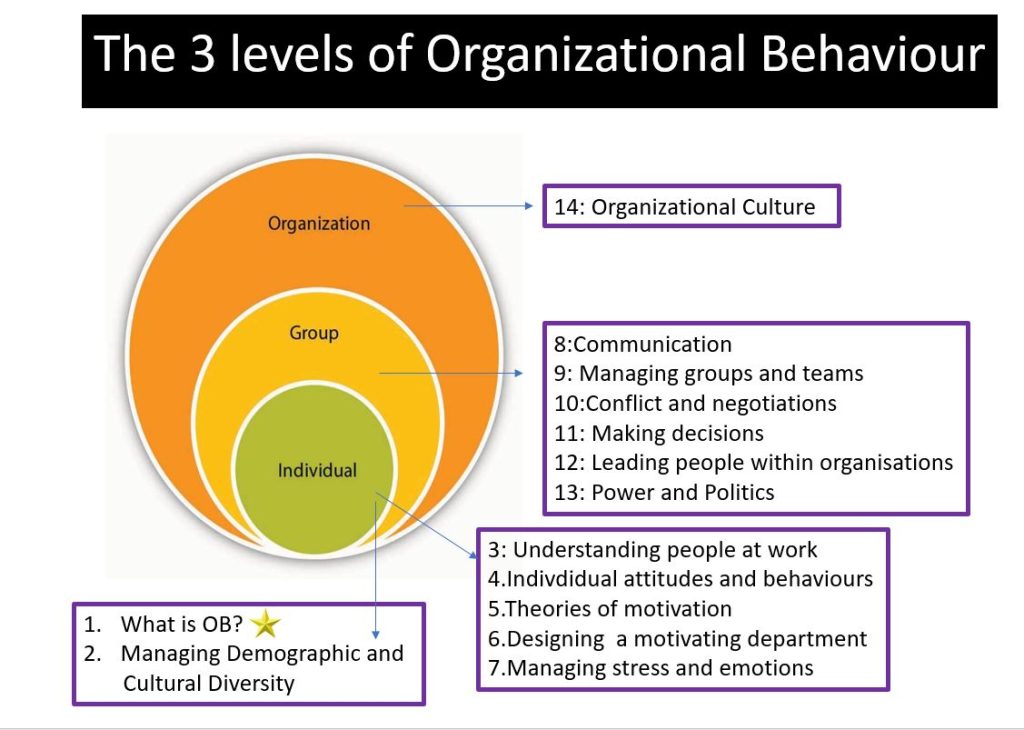
1.4 Exercises



